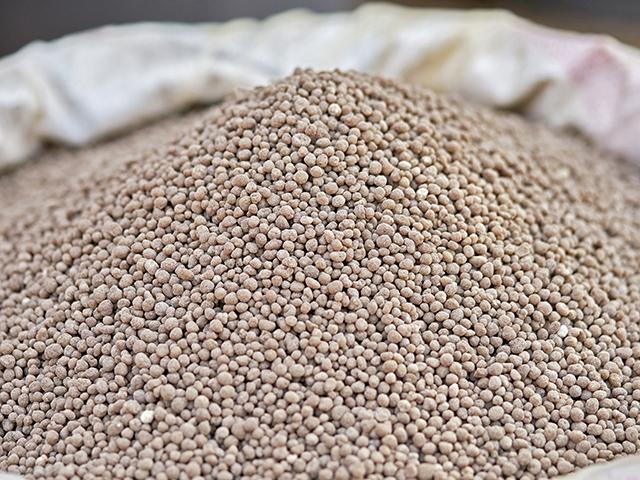Duties Blamed for Fertilizer Price Rise
Nutrients Distributor Vice President Says Import Duties Reason for Higher Fertilizer Prices
LINCOLN, Neb. (DTN) -- Trade disputes and U.S. fertilizer industry consolidation are at the heart of many of the historic fertilizer price increases during the past 18 months, the vice president of a large crop nutrients distributor said during a Farmers for Free Trade event this week.
Brooke McMullin, vice president of International Raw Materials LTD, said while agriculture groups, Midwest lawmakers, governors and others are calling for investigations into fertilizer prices, they need to look no further than ongoing trade disputes with major fertilizer-exporting countries.
A combination of consolidation in U.S. fertilizer production capacity and countervailing duties slapped on fertilizer imports from Russia, Morocco, Trinidad and Tobago have contributed to higher fertilizer prices, he said.
Two fertilizer companies, CF Industries and Mosaic Co., have filed separate antidumping complaints on fertilizer imports into the U.S.
In February 2021, the U.S. Department of Commerce, following a petition filed by Mosaic, recommended the International Trade Commission implement tariffs on fertilizers imported from Morocco. The ITC voted last March to also impose similar tariffs on Russian imports.
Several agriculture interest groups have challenged the ITC's decision in the U.S. Court of International Trade in a case that's ongoing.
"This ruling was made despite the improving prices in the market and the shortage of UAN from domestic producers, particularly west of the Mississippi," McMullin said.
"The predictable result has been higher prices for UAN, as well. Supplies and fertilizers are tight worldwide. But these actions have made the U.S. market particularly squeezed and caused price increases to farmers, livestock producers and consumers that are far higher than otherwise would be."
P[L1] D[0x0] M[300x250] OOP[F] ADUNIT[] T[]
McMullin said the U.S. government applied countervailing dumping duties on the import of phosphates from Russia, ranging from 9% to 47%, and for Morocco of 20% in 2021.
"Today, these percentages would apply against an approximate imported value of U.S. $830 to $840 per metric ton," he said.
The U.S. government currently is investigating the imports of UAN and from Russian, Trinidad and Tobago, McMullin said, after CF Industries filed a petition in June 2021 alleging economic damage from imports of UAN from those countries. In August 2021, the ITC ruled in the company's favor and decided to continue the investigation.
The two countries are the main suppliers of UAN to the world market. Preliminary duties have been set at 19% to 137% for UAN from Russia and 65% for UAN from Trinidad.
"These percentages were brought against our products' import value of $600 per metric ton, which has almost tripled in the past year since this investigation was initiated," McMullin said. "Of course, if the price of fertilizer increases, so does the cost of producing corn and every other crop that relies on these fertilizers, and those price increases are borne by livestock producers as well. Consumers, particularly low-income families, suffer. In fact, the whole food chain has been hurt by the surge in fertilizer prices."
DTN's Russ Quinn reported this week that most fertilizers tracked by DTN continue to be considerably higher in price than one year earlier.
MAP is now 44% more expensive, DAP is 46% higher, 10-34-0 is 60% more expensive, urea is 95% higher, potash is 102% more expensive, UAN32 is 144% higher, UAN28 146% is more expensive and anhydrous is 181% higher compared to last year.
Ed Gresser, president and director for Trade and Global Markets at Progressive Policy Institute, said during a Farmers for Free Trade discussion this week that trade retaliation as a result of the trade war with China has also contributed to the runup in fertilizer prices.
For example, tariffs slapped on pesticides and fertilizer increased from $16 million to $55 million annually under former President Donald Trump.
In a December 2021 interview with DTN, Andy Jung, Mosaic vice-president of market and strategic analysis, said that despite the trade dispute, phosphate imports into the U.S. hit a record level in 2021. U.S. phosphate imports increased by 1.3 million metric tons in 2021, which was 57% higher than during the same January-to-November period in 2020.
Read more on DTN:
"USITC Orders Duties on P Imports," https://www.dtnpf.com/…
"Mosaic: Global Issues Push Prices Up," https://www.dtnpf.com/…
"Iowa AG to Examine Fertilizer Prices," https://www.dtnpf.com/…
Todd Neeley can be reached at todd.neeley@dtn.com
Follow him on Twitter @DTNeeley
(c) Copyright 2022 DTN, LLC. All rights reserved.





